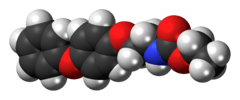Fenoxycarb
| | |
 | |
| Names | |
|---|---|
| IUPAC name
ethyl N-[2-(4-phenoxyphenoxy)ethyl]carbamate | |
| Other names
Varikill, Insegar, Logic | |
| Identifiers | |
| 72490-01-8 | |
| 3D model (Jmol) | Interactive image |
| ChEBI | CHEBI:5009 |
| ChEMBL | ChEMBL15780 |
| ChemSpider | 46739 |
| ECHA InfoCard | 100.069.702 |
| KEGG | C11078 |
| PubChem | 51605 |
| UNII | JEN0LSV1G9 |
| |
| |
| Properties | |
| C17H19NO4 | |
| Molar mass | 301.34 g/mol |
| Melting point | 53.5 °C (128.3 °F; 326.6 K) |
| Except where otherwise noted, data are given for materials in their standard state (at 25 °C [77 °F], 100 kPa). | |
| | |
| Infobox references | |
Fenoxycarb is a carbamate insect growth regulator.[1] It has a low toxicity for bees, birds, and humans, but is toxic to fish. The oral LD50 for rats is greater than 16,800 mg/kg.[2]
Fenoxycarb is non-neurotoxic and does not have the same mode of action as other carbamate insecticides. Instead, it prevents immature insects from reaching maturity by mimicking juvenile hormone.[3]
External links
- Fenoxycarb in the Pesticide Properties DataBase (PPDB)
References
- ↑ Cornell University site on Fenoxycarb
- ↑ U.S. Environmental Protection Agency (1983-85). Chemical Information Fact Sheet. Office of Pesticides and Toxic Substances, Office of Pesticide Programs (TS-766C)
- ↑ John Sullivan, Dept. of Pesticide Regulation, Sacramento CA 2000
This article is issued from Wikipedia - version of the 7/26/2016. The text is available under the Creative Commons Attribution/Share Alike but additional terms may apply for the media files.